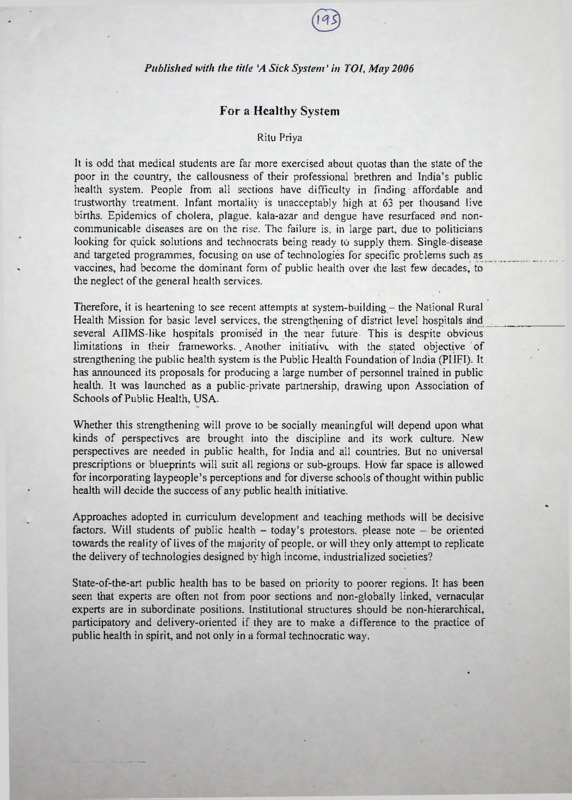For a Healthy System
Item
- Title
- For a Healthy System
- Creator
- Ritu Priya
- Date
- May 2006
- Description
- Published with the title ‘A Sick System’ in TOI, May 2006
- extracted text
-
Published with the title ‘A Sick System’ in TOI, May 2006
For a Healthy System
Ritu Priya
It is odd that medical students are far more exercised about quotas than the state of the
poor in the country, the callousness of their professional brethren and India’s public
health system. People from all sections have difficulty in finding affordable and
trustworthy treatment. Infant mortality is unacceptably high at 63 per thousand live
births. Epidemics of cholera, plague, kala-azar and dengue have resurfaced and noncommunicable diseases are on the rise. The failure is, in large part, due to politicians
looking for quick solutions and technocrats being ready to supply them. Single-disease
and targeted programmes, focusing on use of technologies for specific problems such as
vaccines, had become the dominant form of public health over die last few decades, to
the neglect of the general health services.
Therefore, it is heartening to see recent attempts at system-building - the National Rural
Health Mission for basic level services, the strengthening of district level hospitals and
several AIIMS-like hospitals promised in the near future This is despite obvious
limitations in their frameworks.. Another initiative with the stated objective of
strengthening the public health system is the Public Health Foundation of India (PIIFI). It
has announced its proposals for producing a large number of personnel trained in public
health. It was launched as a public-private partnership, drawing upon Association of
Schools of Public Health, USA.
Whether this strengthening will prove to be socially meaningful will depend upon what
kinds of perspectives are brought into the discipline and its work culture. New
perspectives are needed in public health, for India and all countries. But no universal
prescriptions or blueprints will suit all regions or sub-groups. How far space is allowed
for incorporating laypeople’s perceptions and for diverse schools of thought within public
health will decide the success of any public health initiative.
Approaches adopted in curriculum development and teaching methods will be decisive
factors. Will students of public health - today’s protestors, please note - be oriented
towards the reality of lives of the majority of people, or will they only attempt to replicate
the delivery of technologies designed by high income, industrialized societies?
State-of-the-art public health has to be based on priority to poorer regions. It has been
seen that experts are often not from poor sections and non-globally linked, vernacular
experts are in subordinate positions. Institutional structures should be non-hierarchical,
participatory and delivery-oriented if they are to make a difference to the practice of
public health in spirit, and not only in a formal technocratic way.
India has a track record of being a pioneer in the field of public health. Indian
nutritionists developed vitamin A drops to prevent blindness due to vitamin-A deficiency.
The understanding that protein deficiency occurs secondary to calorie deficiency was
based on Indian data and provided by an Indian at the helm of research at the UN’s FAO.
Research in India in the 1960s created the framework for the tuberculosis programme,
subsequently adopted by most countries. We have regular national data which is stronger
than for most low-income countries, such as from the census and the National Sample
Survey. There have implementation of supplementary feeding programmes of the scale of
the ICDS that provides some nutrition to 4.5 crore children everyday.
The All India Institute of Hygiene & Public Health, various institutes of ICMR, the
National Institute of Health & Family Welfare, Centre of Social Medicine & Community
Health at JNU and the preventive & social medicine departments in medical colleges
have been engaged in public health education, training and research for decades. How
will PHFI relate to these? Experiences from Latin America. Scandinavia and East Asia
can also be explored for diverse options. India is a country with -living- traditions- of •
multiple healing sciences such as Ayurveda, Unani. Siddha and Yoga, which public
health has to understand and draw upon. PHFI, therefore., carries a big responsibility on
its shoulders when it aspires to impact on the health system. So do today’s medical
students, excessively concerned about their careers.
Position: 3642 (2 views)

